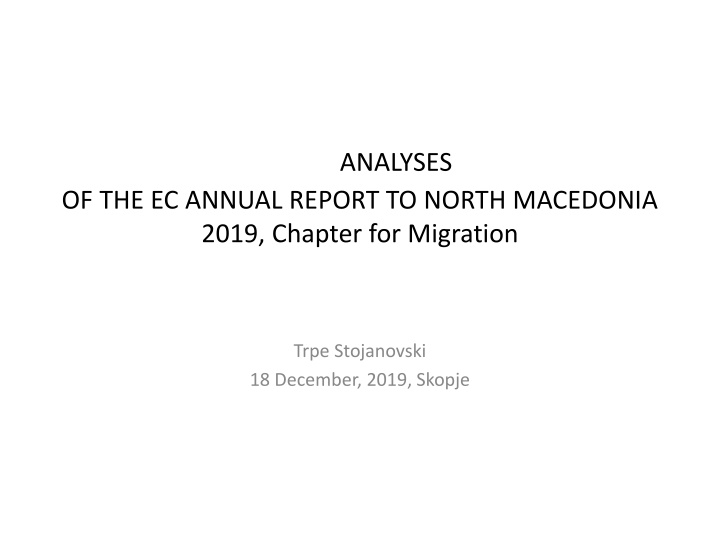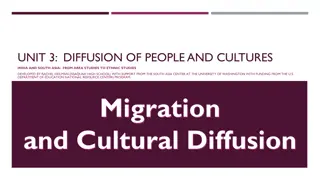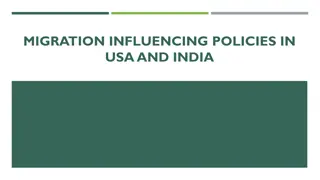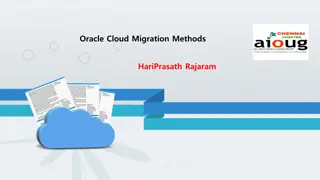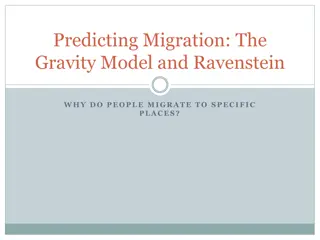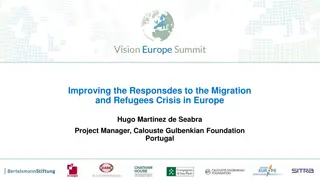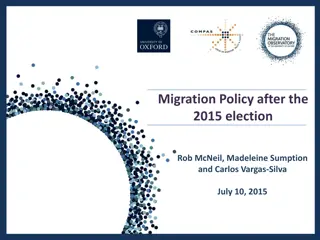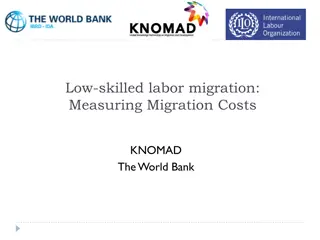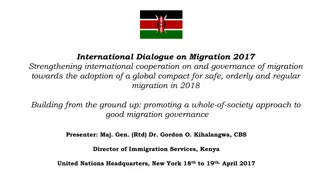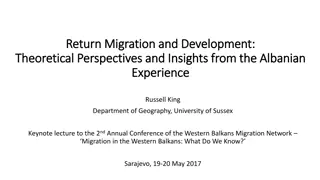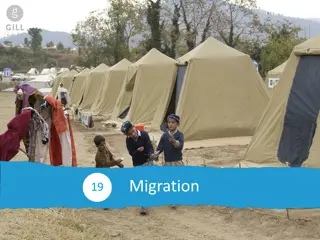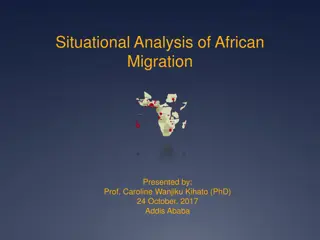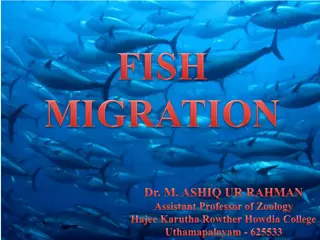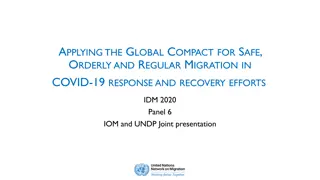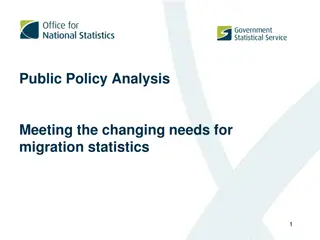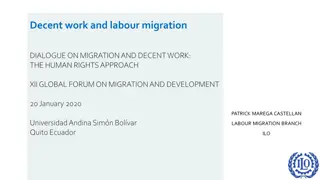Migration Trends in Europe 2018-2019 Analysis
The analysis covers key statistics and trends in migration, including border crossings, returns, and smuggling activities in Europe in 2018-2019. Insights from the FRONTEX Risk Analysis and Statistics highlight changes in migratory pressures and routes, with a focus on the Western Balkans and the Mediterranean. The report also discusses legal frameworks and institutional setups related to migration management during this period.
Download Presentation

Please find below an Image/Link to download the presentation.
The content on the website is provided AS IS for your information and personal use only. It may not be sold, licensed, or shared on other websites without obtaining consent from the author.If you encounter any issues during the download, it is possible that the publisher has removed the file from their server.
You are allowed to download the files provided on this website for personal or commercial use, subject to the condition that they are used lawfully. All files are the property of their respective owners.
The content on the website is provided AS IS for your information and personal use only. It may not be sold, licensed, or shared on other websites without obtaining consent from the author.
E N D
Presentation Transcript
ANALYSES OF THE EC ANNUAL REPORT TO NORTH MACEDONIA 2019, Chapter for Migration Trpe Stojanovski 18 December, 2019, Skopje
FRONTEX Risk Analysis for 2019 various indicators related to the EU s external borders and migration in 2018: 190 930 refusals of entry (up 4%) 148 121 effective returns by member states (down 5%) 13 728 returns coordinated or organized by Frontex (down 3%) 10 642 detections of people smugglers/facilitators (up 4%)
FRONTEX Statistics In 2018, the number of detections of illegal border crossings reached its lowest level in five years, but migratory pressure remained relatively high at the EU s external borders The total figure fell 27% from the previous year (2017) to 150 114 and was 92% below the peak of the migratory in 2015. The Western Mediterranean became the most frequently used route into Europe. The pressure on Spain has been rising over the last years, and the number of detections in 2018 reached 57 034, double the number from 2017. The Eastern Mediterranean saw only slightly fewer detections than the Western Mediterranean route. With 56 561 illegal border crossings, the pressure was 34% higher than in the preceding year due to the increase in land crossings from Turkey to Greece.
FRONTEX Statistics The Western Balkans continued to be transited by irregular migrants trying to reach Western Europe from Turkey. Two main routes through the region stood out in 2018 with pressure shifting between them as border control activities were enhanced and reinforced in certain areas. Migrants travelled via both the central route via Serbia and the route stemming from the Greek- Albanian border section, along the Bosnian and Herzegovinian Croatian Slovenian corridor and, to a lesser extent, on Serbia s EU borders with Hungary, Croatia and Romania. Last year Frontex began to collect detailed data on the gender and the age of irregular migrants. Nearly one in five of all the detected migrants last year claimed to be under the age of 18. The Eastern, Western and Central Mediterranean routes represented the main entry points for arriving children. This new development is crucial not only for a better monitoring and understanding of incoming migratory flows, but also for the effective identification of vulnerable groups
EC Annual Report to North Macedonia 2019 Legal and irregular migration - Institutional set-up and legal alignment Progress was made in improving the legal framework with the adoption of amendments to the Law on International and Temporary Protection and the Law on Foreigners. The crisis situation at the country s borders was extended until 30 June 2019, authorizing continued deployment of the army. There is a fragmentation of tasks between the institutions dealing with migration. Responsibilities are shared between the Ministry of the Interior's Unit for Border Affairs and Migrants (which deals with security aspects and management of the borders), the Ministry of Labour and Social Policy (which manages access to services and socioeconomic integration of migrants and refugees) and the Department for Serious and Organised Crime s specialized unit fighting trafficking in human beings and people smuggling.
Implementation and enforcement capacity Macedonia continues to play an active and constructive role in the management of mixed migration flows. It cooperates effectively with EU MS and neighboring countries. Considerable efforts to ensure basic living conditions and services for all migrants staying in the country continued. There are still uncertainties on the scope and structure of migration flows. The inconsistent registration of migrants apprehended in irregular movements prevents regular and adequate protection-sensitive profiling and the referral to national protection mechanisms. With the assistance of the army and deployment of guest officers from EU MS effective control at the southern border has been ensured. The regular smuggling activities at the northern border needs to be further addressed.
Implementation and enforcement capacity The country continues to be under severe pressure due to its geographic location. The migratory flows continued to be largely transitory, with most migrants arriving from Greece and leaving North Macedonia after a couple of days. The number of officially reported illegal crossings has substantially increased compared with the previous year (16 895 attempts in 2018 compared to 2 831 in 2017) reportedly mainly on the southern border with Greece (13 494). The number of migrants transiting the country is considered to be much higher than official figures. About 32 500 migrants are considered to have illegally crossed the country's borders in both directions since the beginning of 2018, including many Iranians crossing illegally from Serbia and moving onwards to Greece.
Implementation and enforcement capacity The Resolution on Migration Policy adopted by the government in 2015 is the main policy document in this field. One of its strategic priorities is to identify migrants, profile them, and refer them to the appropriate protection system. Progress was made on improving reception conditions in the asylum centre in Vizbegovo. In 2018, a total of 299 individuals applied for asylum. The country continued to arbitrarily detain a number of people apprehended in irregular movements in order to ensure their witness statements in court cases against smugglers. The transit centres for migrants near Gevgelija and Tabanovce are almost empty. Neither of the transit centres is suitable for long-term stays, and the authorities continue to be reluctant to provide more than a temporary stay.
Readmision The readmission agreement with the EU is being implemented in a satisfactory manner in regards to own nationals. The return rate shows that citizens who are ordered to leave the EU are effectively returned, with a high share of Roma. Macedonia needs to develop services for returnees and to revive the coordinating body on returnees. The country needs to put in place a return mechanism for irregular migrants, in line with the acquis. More effort is needed to successfully reintegrate returnees, especially the most vulnerable such as Roma. Increased cooperation communication and coordination is needed between central level governments, among central and local authorities and with international organizations and NGOs active in the reintegration of returnees. The government should consider reviving and reinforcing the coordination body of returnees under the leadership of the Ministry of Labour and Social Policy.
Recommendations addressed to the state institutions Further investment and strengthening the capacities in improving the system for identification and offering services to the migrants Further Strengthening the capacities for improved cooperation between the central government institutions in exchanging the relevant information Further investments and strengthening the performances of the law enforcement in prevention and fighting the smuggling of migrants More intensive cooperation with and integration in Frontex, EASO and Europol networks
